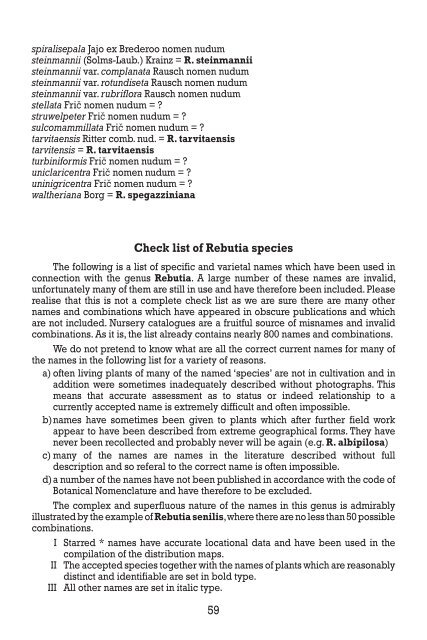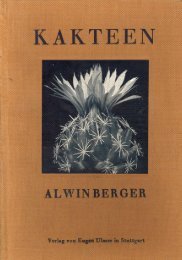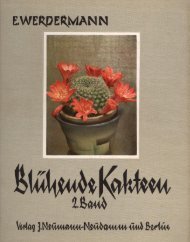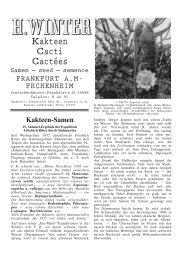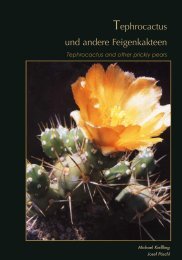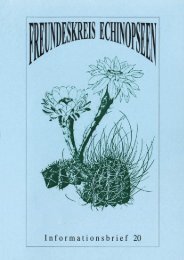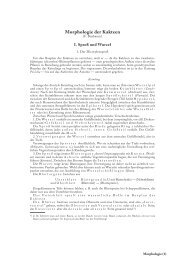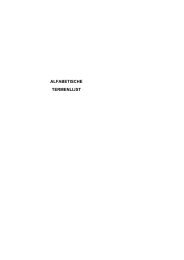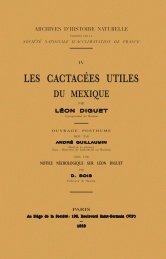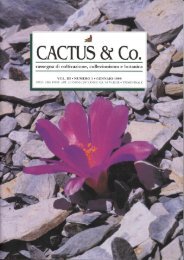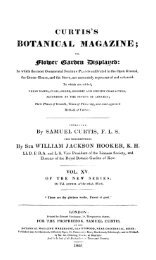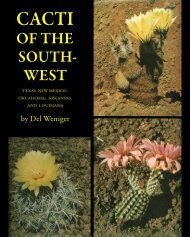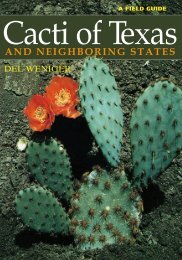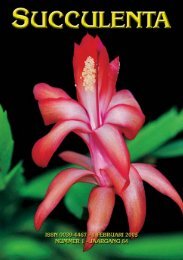the genus rebutia 1895—1981 - Free
the genus rebutia 1895—1981 - Free
the genus rebutia 1895—1981 - Free
You also want an ePaper? Increase the reach of your titles
YUMPU automatically turns print PDFs into web optimized ePapers that Google loves.
spiralisepala Jajo ex Brederoo nomen nudum<br />
steinmannii (Solms-Laub.) Krainz = R. steinmannii<br />
steinmannii var. complanata Rausch nomen nudum<br />
steinmannii var. rotundiseta Rausch nomen nudum<br />
steinmannii var. rubriflora Rausch nomen nudum<br />
stellata Frič nomen nudum = ?<br />
struwelpeter Frič nomen nudum = ?<br />
sulcomammillata Frič nomen nudum = ?<br />
tarvitaensis Ritter comb. nud. = R. tarvitaensis<br />
tarvitensis = R. tarvitaensis<br />
turbiniformis Frič nomen nudum = ?<br />
uniclaricentra Frič nomen nudum = ?<br />
uninigricentra Frič nomen nudum = ?<br />
wal<strong>the</strong>riana Borg = R. spegazziniana<br />
Check list of Rebutia species<br />
The following is a list of specific and varietal names which have been used in<br />
connection with <strong>the</strong> <strong>genus</strong> Rebutia. A large number of <strong>the</strong>se names are invalid,<br />
unfortunately many of <strong>the</strong>m are still in use and have <strong>the</strong>refore been included. Please<br />
realise that this is not a complete check list as we are sure <strong>the</strong>re are many o<strong>the</strong>r<br />
names and combinations which have appeared in obscure publications and which<br />
are not included. Nursery catalogues are a fruitful source of misnames and invalid<br />
combinations. As it is, <strong>the</strong> list already contains nearly 800 names and combinations.<br />
We do not pretend to know what are all <strong>the</strong> correct current names for many of<br />
<strong>the</strong> names in <strong>the</strong> following list for a variety of reasons.<br />
a) often living plants of many of <strong>the</strong> named ‘species’ are not in cultivation and in<br />
addition were sometimes inadequately described without photographs. This<br />
means that accurate assessment as to status or indeed relationship to a<br />
currently accepted name is extremely difficult and often impossible.<br />
b) names have sometimes been given to plants which after fur<strong>the</strong>r field work<br />
appear to have been described from extreme geographical forms. They have<br />
never been recollected and probably never will be again (e.g. R. albipilosa)<br />
c) many of <strong>the</strong> names are names in <strong>the</strong> literature described without full<br />
description and so referal to <strong>the</strong> correct name is often impossible.<br />
d) a number of <strong>the</strong> names have not been published in accordance with <strong>the</strong> code of<br />
Botanical Nomenclature and have <strong>the</strong>refore to be excluded.<br />
The complex and superfluous nature of <strong>the</strong> names in this <strong>genus</strong> is admirably<br />
illustrated by <strong>the</strong> example of Rebutia senilis, where <strong>the</strong>re are no less than 50 possible<br />
combinations.<br />
I Starred * names have accurate locational data and have been used in <strong>the</strong><br />
compilation of <strong>the</strong> distribution maps.<br />
II The accepted species toge<strong>the</strong>r with <strong>the</strong> names of plants which are reasonably<br />
distinct and identifiable are set in bold type.<br />
III All o<strong>the</strong>r names are set in italic type.<br />
59<br />
unigricentra -><br />
uninigricentra


